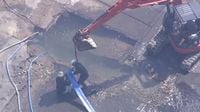A large-scale flooding incident unfolded early on April 30, 2025, in central Kyoto, specifically at the Takakura intersection of National Route 1. Reports began flooding in around 3:30 AM from concerned passersby who noted that water was gushing onto the road. This prompted immediate action from local authorities, including the Kyoto Prefectural Police, who quickly implemented traffic regulations in the area due to the hazardous conditions.
According to the Kyoto City Waterworks Bureau, the flooding was likely caused by a leak from a 30-centimeter diameter cast iron water pipe that was installed back in 1959. The Bureau confirmed that this aging infrastructure has been under scrutiny, as the surrounding area was already scheduled for pipe renewal work. Unfortunately, it seems that the deterioration of this particular pipe led to a significant failure, resulting in water spilling onto the roadway.
By 4:40 AM, traffic restrictions were in place from the Gojo-Tomicho intersection to the Takakura intersection, leading to major congestion in both east and west directions. Witnesses described the scene as alarming, with the asphalt raised by 20 to 30 centimeters in multiple locations, creating a hazardous environment for both pedestrians and drivers. One local man recounted how he was awakened by a strange noise around 3:30 AM, only to find that approximately 20 centimeters of water had entered his home.
The situation escalated as the flooding affected not only the roads but also nearby residences, with some experiencing underfloor flooding. Local authorities, including the Kyoto City Waterworks Bureau and Shimogyo Police Station, have been actively communicating with residents to explain the ongoing situation and to provide assistance. A nearby supermarket manager reported that the tap water had become cloudy, raising concerns about its safety for food preparation. As a precaution, they have been relying on bottled water to meet their needs.
In response to the crisis, the Waterworks Bureau has dispatched six water supply trucks to assist those affected by the murky water. Residents have expressed their anxiety over the situation, with one woman stating, “I want to know the cause soon.” Another local, a man in his 60s, expressed his worries about the potential for significant traffic disruptions during the Golden Week holidays, highlighting the broader implications of such infrastructure failures.
As the investigation into the cause of the flooding continues, the Expo Association is also dealing with its own crisis. An automated bus involved in the Expo was reported to have caused an accident while in manual mode, with the operator away from their seat. Authorities are currently investigating whether this incident stemmed from human error or a system malfunction, leading to the suspension of operations for four similar buses.
With the flooding situation still developing, residents are left to grapple with the immediate impact on their lives and the uncertainty of when normalcy will return. The ongoing infrastructure issues in Kyoto have raised alarms about the city's preparedness for such emergencies, especially as aging water pipes are increasingly becoming a liability.
As of now, the outlook for recovery remains unclear, with local officials working diligently to address the situation and restore services. The community's resilience is being tested as they navigate the challenges posed by both the flooding and the broader implications of infrastructure decay in the region.



